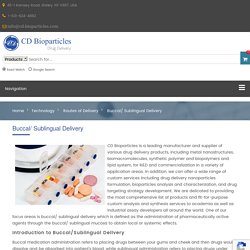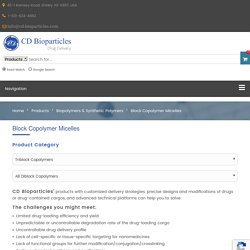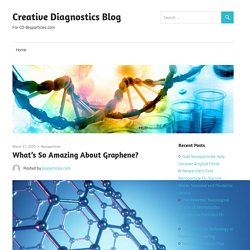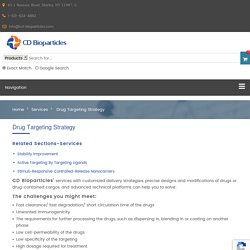Zoom
Trash

Bioparticles. DiagPoly™ Ni-NTA PS Particles, 5 µm. CD63 Exosome Isolation Kit, Serum Plasma. Amine Magnetic Particles, PEG Spacer Arm, Smooth Surface. Amine Magnetic Particles Conjugation Kit, 500 nm, BS3 as Cross-linker. Fluorescent Lipids, Lipid System. Click Reagents, Lipid System. Bacterial Lipids, Lipid System. Adjuvants, Lipid System. Buccal/ Sublingual Delivery. CD Bioparticles is a leading manufacturer and supplier of various drug delivery products, including metal nanostructures, biomacromolecules, synthetic polymer and biopolymers and lipid system, for R&D and commercialization in a variety of application areas.

In addition, we can offer a wide range of custom services including drug delivery nanoparticles formulation, bioparticles analysis and characterization, and drug targeting strategy development. We are delicated to providing the most comprehensive list of products and fit-for-purpose custom analysis and synthesis services to academia as well as industrial assay developers all around the world. One of our focus areas is buccal/ sublingual delivery which is defined as the administration of pharmaceutically active agents through the buccal/ sublingual mucosa to obtain local or systemic effects. Introduction to Buccal/Sublingual Delivery In recent years, researchers focus on studying particulates used for buccal mucosa delivery.
Figure 1. Block Copolymer Micelles, Biopolymers & Synthetic Polymers. CD Bioparticles’ products with customized delivery strategies, precise designs and modifications of drugs or drug-contained cargos, and advanced technical platforms can help you to solve: The challenges you might meet: Limited drug-loading efficiency and yieldUnpredictable or uncontrollable degradation rate of the drug-loading cargo Uncontrollable drug delivery profile Lack of cell-specific or tissue-specific targeting for nanomedicines Lack of functional groups for further modification/conjugation/crosslinkingTedious chemical synthesis and purifications Key Features Key benefits:

Biodegradable Polymers, Biopolymers & Synthetic Polymers. Lipid, Polymer Nanoparticles for Drug Delivery. Biotin Magnetic Particles. Ag2S Quantum Dots. Creative Diagnostics provides NIR-II-emitting Ag2S quantum dots (QDs).

It is well known that light from visible to NIR wavelengths (650–1350 nm) is noninvasive for detecting and imaging of abnormal tissue. The NIR optical window consist of the first near-infrared region (NIR-I; 650-000 nm) and the second near-infrared region (NIR-II; 1000-1700 nm). The NIR-II can be more conducive to imaging than NIR-I due to lower fluorescence and reduced light scattering. NIR-II QDs mainly include Ag2S, Ag2Se, Ag2Te, PbS, PbSe, InAs, Cd3P2, Cd3As2, CdTe, HgTe. However, the toxic elements such as cadmium, mercury, lead, and arsenic, have seriously affected their application in the biomedical field. Applications Optical imagingPhotoacoustic imagingSensingOptical trackingPhotothermal therapy.
Quaternary Amine PS/DVB Particles, 10 μm. DiagPoly™ Ni-NTA PS Particles, 5 µm. CD63 Exosome Isolation Kit, Serum Plasma. Amine Magnetic Particles, PEG Spacer Arm, Smooth Surface. Amine Magnetic Particles Conjugation Kit, 500 nm, BS3 as Cross-linker. What’s So Amazing About Graphene? – Creative Diagnostics Blog. What is graphene?

Graphene, which is actually stripped from graphite, is a two-dimensional crystal made up of carbon atoms with only one layer of atomic thickness. The graphite used for pencil leads is equivalent to countless layers of graphene stacked on top of each other. Graphene, which sounds ordinary, has many unique properties. Popularly speaking, in nature at present, this thing is the thinnest and strongest material with excellent electrical conductivity, almost omnipotent in the industrial field. How thin is graphene? The unfolded area of 1 gram of graphene is 2630 m2. Graphene has very low resistivity and electrons can move in it very efficiently, which makes graphene have very good electrical conductivity. Graphene also has the zero permeability characteristic of “needle can not be inserted, water can not be splashed into”.
Graphene has come into daily life With the development of scientific research, at present, graphene products begin to come into our daily life. Lateral Force Microscopy (LFM) - AFM Nanoprobes. Kelvin Probe Microscopy - AFM Nanoprobes. High Resolution Imaging - AFM Nanoprobes. High Aspect Ratio AFM Probes - AFM Nanoprobes. The spatial resolution of the surface imaged by the atomic force microscope depends on two properties of the tip: the radius of the tip and the aspect ratio.

The aspect ratio refers to the ratio of the height and width of the AFM tip. The standard AFM probe made of silicon has a conical, pyramidal or tetrahedral tip. The conical tip can be manufactured to have a relatively high aspect ratio. However, these conventional probes cannot accurately solve the morphology of highly non-planar features, such as deep trenches and narrow trenches that are common in semiconductor device processing. This is because the height and width of the probe are shorter than the height of the side wall and wider than the interval between the side walls of the structure.
Length 94/124 Thickness 1.85/1.85 Width 34/34. PacFA, Toolbox. Buccal/ Sublingual Delivery. Drug Targeting Strategy. Related Sections-Services CD Bioparticles’ services with customized delivery strategies, precise designs and modifications of drugs or drug-contained cargos, and advanced technical platforms can help you to solve: The challenges you might meet: Fast clearance/ fast degradation/ short circulation time of the drugs Unwanted immunogenicity The requirements for further processing the drugs, such as dispersing in, blending in or coating on another phase Low cell-permeability of the drugs Low specificity of the targeting High dosage required for treatment High side-effect of the toxic chemotherapeutic agents Tedious searching and conjugation of receptor-targeting-moieties Low stability or low activity of the drugs after various barriers within a biological system Highly frequent feeding of the drugs The requirements of sustained release, pulse release, and delayed release The requirements of the delivery at specific period, specific location, and specific dosage.

DDAB Liposomes for DNA/RNA Delivery, Liposomes for DNA/RNA Delivery. Biodegradable Polymers, Biopolymers & Synthetic Polymers. Poly(caprolactone)s, Biodegradable Polymers. Solid Lipid Nanoparticle Production. CD Bioparticles provides custom services for solid lipid nanoparticle production to prolong drug circulation time.

Based on our deep understanding of solid lipid nanoparticle, our scientist team can provide professional solutions for solid lipid nanoparticle preparation and characterization. Introduction to Solid Lipid Nanoparticles Solid lipid nanoparticles typically contain a hydrophobic solid matrix core with one layer of a phospholipid coating (Figure 1), and it is typically spherical with an average diameter between 10 and 1000 nanometers. Solid lipid nanoparticles are prepared by using solid lipids (e.g., purified triglycerides, fatty acids, steroids, or waxes) that can solubilize lipophilic molecules, emulsifiers that stabilize the core, and water.
The hydrophobic tail regions of the phospholipid are embedded into the core matrix resulting in the core exclusively possesses a hydrophobic nature for drug encapsulation. Figure 1. Solid Lipid Nanoparticles Applications References: 1. Drug Delivery Nanoparticles Formulation. Related Sections-Services CD Bioparticles’ services with customized delivery strategies, precise designs and modifications of drugs or drug-contained cargos, and advanced technical platforms can help you to solve: The challenges you might meet: Drugs/Active pharmaceutical ingredient (API) which are hard to be dispersed or dissolved in different solvent systems Limited options for drug/API encapsulation into different formats (size, structure, crystallization) Limited options of drug/API loading carriers for different types of drugs/API Low specificity of the targeting High dosage required for treatment High side-effect of the toxic chemotherapeutic agents Tedious materials synthesis, modification, and production Key features:

Lanthanide-Based Magnetic Particles. Lanthanide-Based Magnetic Particles The Absolute Mag™ Lanthanide-Based Magnetic Particles is a kind of super-paramagnetic magnetic particles formed by the reaction of a strong lanthanide element (Ln) mono-electronic oxidant with Massart magnetite under high-power ultrasonic irradiation.

These particles have a γ-Fe2O3 core and are positively charged, hydrophilic, and not easy to aggregate in aqueous suspensions/ferrofluids due to electrostatic repulsion. Since the lanthanide elements have a characteristic oxidation state of +3 valence, it is readily reacts with the Lewis base, therefore, the particles can also be further functionalization. CAN-Fe2O3 Nanoparticles are especially recommended here for innovatively gene silencing application. Features: First « 1 – 5 / 5 » Last. Functional Quantum Dots. Creative Diagnostics provides water-soluble quantum dots with different functional groups, including amine, carboxyl, GSH (glutathione), and MPA (3-Mercaptopropionic acid).

GSH or MPA quantum dots have the hydrodynamic sizes of 10-12 nm diameters, while PEG-NH2 and PEG-COOH quantum dots are about 20 nm in size. PEG functionalized quantum dots have much better performance in solubility and pH stability. Amine and carboxyl quantum dots available with a PEG spacer are ideal for covalent conjugation with proteins, antibodies and other biomolecules. Generally, our water-soluble functional QDs have great potential to be used in highly sensitive cellular imaging, molecular recognition and optical devices. Applications: Gold Nanoparticles Conjugation Kits. Gold Nanoparticles Conjugation Kits Creative Diagnostics offers different Gold Nanoparticles Conjugation Kits optimized for conjugation of gold nanoparticles to antibodies, oligonucleotides and other proteins.
Our NHS-activated Gold Nanoparticles Conjugation Kits are suitable for high efficacy conjugation of gold nanoparticles with antibodies and primary amine-containing molecules. Our OligoBindTM Conjugation Kits are easy-to-use for conjugation gold nanoparticle with oligonucleotides via a thiol group chemically introduced to either its 5´- or 3´-end. Creative Diagnostics Conjugation Kits are excellent tools for early stage R&D to quickly selection for most adequate gold nanoparticles conjugates for your projects. Silica Magnetic Particles. Silica Magnetic Particles The DiagNano™ silica magnetic particles are produced by hydrolysis of orthosilicates in the presence of magnetite and have a hydrophilic surface with terminal Si-OH-bonds and can easily be separated with conventional permanent magnets.
They are extremely stable in organic solvents and at high temperatures. Silica coating not only contributes to the improved stability and prolonged shelf-life due to inertness of silica, but also facilitates the surface functionalization by providing various active reacting groups, including OH, NH2, COOH, SH, N-hydroxysuccinimide (NHS) and epoxy for the covalent binding of proteins, antibodies, or other molecules. It can also be used for nucleic acids isolation and purification though the DNA/RNA-silica interaction method created by Boom et al. in 1990, with improved efficiency and simplified operation. First « 1 – 20 / 45 » Last. Water and Wastewater Treatment. Water is an indispensable substance in human life and production. With the development of industry, the problem of water pollution has become more and more serious.
For example, heavy metals (such as Pb2+, As3+, Cu2+, Cr6+, Cd2+, Co3+, Mn2+, and Hg2+) in industrial production enter the natural water body with the discharge of industrial wastewater, resulting in heavy metal pollution in the water. Even at low concentrations, heavy metals can cause significant toxicity to microorganisms. People have paid a lot of attention to water and wastewater treatment. Nanomaterials have been actively researched and developed over the past few decades and have been successfully used in many fields such as catalysis, medicine, sensing, and biology.
Quantum Dots. Creative Diagnostics provides a comprehensive list of DiagNano™ semiconductor quantum dots with different chemical compositions and surface functionalization. Our quantum dots have uniform size, tunable emission and high quantum yield, as well as good thermal stability. The electronic characteristics and band gap of quantum dots are closely related to its size and shape.
Fluorescent Silica Particles. Fluorescent Silica Particles Creative Diagnostics provides silica particles with a high amount of covalently bound fluorescence dye in the silica matrix. The fluorescent silica nanoparticles are available with red fluorescence (excitation: 569 nm, emission: 585 nm), green fluorescence (excitation: 485 nm, emission: 510 nm) and blue fluorescence (excitation: 354 nm, emission: 450 nm). Different surface functionalities including Si-OH, NH2 and COOH enable covalent binding of proteins, antibodies, oligonucleotides, and other molecules. These particles have broad applications in immunoassays such as flow cytometry, membrane checks, as well as flow investigations. Figure 1 Fluorescence images of HeLa cells stained with fluorescent silica nanoparticles. Applications: Fluorescent imaging and multimodal imagingDrug and gene deliveryTheranostics platform First « 1 – 20 / 131 » Last. Upconverting Nanoparticles. Upconverting Nanoparticles Creative Diagnostics provides a comprehensive list of upconverting nanoparticles with different surface ligands as well as variable emission range.
Lipids For Bicelle Formation, Formulations - CD Bioparticles. Cationic Detergents, Detergents - CD Bioparticles. Anionic Detergents, Detergents - CD Bioparticles. Click Reagents, Lipid System - CD Bioparticles. DC-Cholesterol, Cationic Lipids (Transfection) - CD Bioparticles. Lysyl-phosphatidylglycerol (Lys-PG), Bioactive Lipids - CD Bioparticles. Bioactive Lipids, Lipid System - CD Bioparticles. Buccal/ Sublingual Delivery - CD Bioparticles. Self-Assembled Monolayers Reagents - CD Bioparticles.
Creative Diagnostics offers a series of Self-Assembled Monolayers (SAM) Reagents formed with thiol and disulfide derivatives. Self-Assembled Monolayers are prepared by immersing a clean gold-coated glass plate into a dilute solution of the desired thiol. SAM can be formed with different terminal function groups through various alkanethiol derivatives (collectively called SAM Formation Reagents), to generate a monolayer surface with functionality that is able to attach biological molecules for biosensor construction. SAM Formation Reagents which are already optimized in one bottle and simple to use.
The optimized reagent can reduce unspecific binding significantly. Self-assembled monolayers (SAMs) are a single layer of highly ordered molecules of a surfactant formed spontaneously on a substrate when exposed to a surfactant solution. Properties and Applications of Upconversion Nanoparticles - CD Bioparticles. Introduction. Polylactide(PLA) - CD Bioparticles. Creative Diagnostics has developed a full range of polylactide (PLA) micro- and nanoparticles with multiple sizes from 250 nm to 100 µm. PLA particles are considered as most commonly used bioresorbable polymers in the biomedical research because of their degradation rate and good mechanical properties.
Due to their excellent biocompatibility, PLA particles and their copolymers are becoming widely used in tissue engineering for function restoration of impaired tissues. Our PLA particles are available with plain or functionalized surface for a variety of biomedical applications, such as drug delivery, bioimaging and biomedical devices. Properties and Applications of Gold Nanoparticles - CD Bioparticles. Introduction Gold nanoparticles have attracted great interests in the fields of biological and medical applications in past few years.
Quantum Dots - CD Bioparticles. Properties and Applications of Quantum Dots - CD Bioparticles. Introduction Quantum dots (QDs) are often referred to very tiny man-made semiconductor particles, whose size are normally no more than 10 nanometers. Their extremely small size renders their optical and electronic properties different from those of bulk materials. Nanoparticles - CD Bioparticles. Properties and Applications of Carbon Nanoparticles - CD Bioparticles. Introduction Graphene, carbon nanotubes (CNT), and fluorescent carbon quantum dots (CQDs) pertain to carbon materials family. N-acylhomoserine lactone (AHL), Bacterial Lipids - CD Bioparticles. Cardiolipin Lipids (CL) Liposomes, Plain Liposomes - CD Bioparticles. Buccal/ Sublingual Delivery - CD Bioparticles. Biotinylated Liposomes, Reactive Liposomes - CD Bioparticles. Biopolymers & Synthetic Polymers, Products - CD Bioparticles.
Bioparticles Zeta Potential Analysis - CD Bioparticles. Measurement of zeta potential (ζ-potential) is currently the simplest and most straightforward way to characterize the surface of charged colloids. Active Drug Targeting by Aptamers - CD Bioparticles. CD Bioparticles offers custom services for nanocarriers which have targeting ligands. Aptamers have been widely explored as targeting ligand in the past three decades to deliver therapeutic as well as diagnostic agents in biomedical research due to its unique chemical features and biological functions. 4-Arm PEGs, PEG Conjugations - CD Bioparticles. Coated Silver Nanoparticles - CD Bioparticles. PbSe Quantum Dots - CD Bioparticles. Gold Coated Magnetic Nanoparticles - CD Bioparticles. DiagPoly™ Ni-NTA PS Particles, 5 µm - CD Bioparticles. What’s So Amazing About Graphene? – Creative Diagnostics Blog. Poly(Methyl Methacrylate) (PMMA) - CD Bioparticles.
Protein Isolation - Technical Platform - CD Bioparticles. PEG-MAHG Silica-Coated Gold Nanoparticles, 30 nm, Silica Shell 30 nm - CD Bioparticles. Click Reagents, Lipid System - CD Bioparticles. Magnetic Liposomes, Liposome System - CD Bioparticles. Bacterial Lipids, Lipid System - CD Bioparticles. Liposomes for Cosmetics, Liposome System - CD Bioparticles. Natural Lipids, Lipid System - CD Bioparticles.
Drug Delivery Nanoparticles Formulation - CD Bioparticles. Oral Delivery - CD Bioparticles. Biodegradable Polymers, Biopolymers & Synthetic Polymers - CD Bioparticles. Drug Delivery - Technical Platform. Nanoparticles. Properties and Applications of Carbon Nanoparticles. Properties and Applications of Silver Nanoparticles. Gold Nanoshells. Self-Assembled Monolayers Reagents. Properties and Applications of Upconversion Nanoparticles. Polylactide(PLA) Liposomal Doxorubicin, Drug Loaded Liposomes - CD Bioparticles.
Chitosans, Biodegradable Polymers - CD Bioparticles. Bioactive Lipids, Lipid System - CD Bioparticles. Drug Delivery Nanoparticles Formulation - CD Bioparticles. Dextrans, Biodegradable Polymers - CD Bioparticles. Solid Lipid Nanoparticle Production - CD Bioparticles. Monomers, Biopolymers & Synthetic Polymers - CD Bioparticles. Clipos™ Nanoliposomal Vitamin A Palmitate, Liposomes for Cosmetics - CD Bioparticles. MagIso™ CD9 Exosome Isolation Kit, Serum Plasma. MagIso™ CD31 Exosome Isolation Kit for FACS.